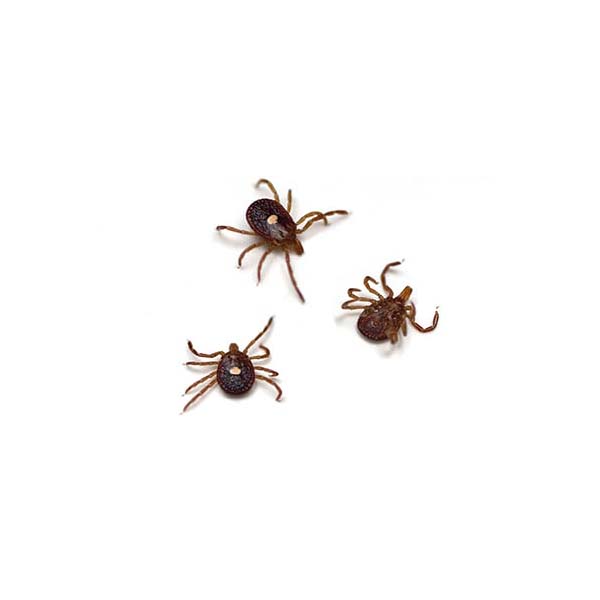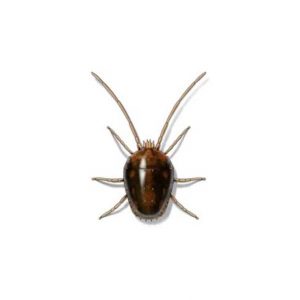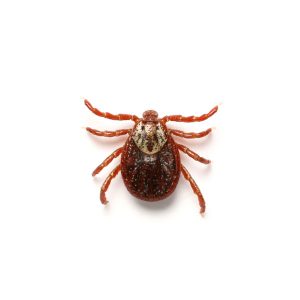What Is a Lone Star Tick?
The Lone Star Tick, scientifically known as Amblyomma americanum, is a tiny, parasitic arachnid that feeds primarily on the blood of mammals, including humans. This tick species is widespread across the southeastern and eastern United States, where its bite is infamous for transmitting various serious diseases. The tick gets its name from the distinctive white spot or “lone star” found on the back of adult female ticks, making it one of Georgia’s most easily recognized ticks. Due to its prevalence and the health risks it poses, proper identification and understanding of this tick species are essential, especially for those living in areas where it is common.
What Do Lone Star Ticks Look Like?
Lone Star Ticks are flattened from top to bottom, a characteristic that is consistent across different life stages. Adult and nymph ticks have 8 legs, while larval ticks have 6 legs.
Adult females are particularly noticeable due to a single white spot on their reddish-brown body, a key identifier. This spot is located behind the scutum, the front section of the tick’s body. The scutum itself is brown or black, and the spot at the very back of it can be either white or silver-colored. In contrast, adult males lack this white spot but have scattered white or silver streaks, bands, or stripes along the outermost parts of their brown or black bodies. These markings provide a useful way to distinguish male Lone Star Ticks from other tick species.
The size of Lone Star Ticks can vary, with adult ticks measuring about 3 to 4 millimeters in length when unfed. However, like many other tick species, they can swell significantly after feeding, becoming much larger and more engorged as they fill with blood. Their body shape is typically flat and oval before feeding, a form that becomes rounded as they feed. The tick’s mouthparts are long and robust, designed to attach firmly to their host, including humans, pets, and wildlife. This is an essential feature for their survival, as all life stages of the Lone Star Tick feed on blood.
Habitat
There is no one primary host of this type of tick. They can and will get on numerous animals and humans. The nymphal and juvenile stages are found on smaller mammals or birds but can occasionally get on larger animals or humans. They are common throughout most of the United States and can be found in areas where their hosts reside. They wait on grass or tall foliage and attach to a host as it passes. After feeding, the tick drops off its host to lay eggs or molt. These ticks mate while on the host, and once the female has taken a blood meal, she will detach and fall to the ground to lay her eggs.
Understanding the habitat of Lone Star Ticks is crucial for anyone looking to protect themselves, their families, and their pets from tick bites and the diseases these pests can transmit. Lone Star Ticks thrive in warm, humid environments, making them familiar in regions with dense underbrush and wooded areas where their hosts—humans, pets, and wildlife—are abundant.
What Attracts Lone Star Ticks?
Lone Star Ticks are drawn to areas with thick vegetation and abundant hosts. They are attracted by carbon dioxide, heat, and movement, which signal the presence of potential hosts like deer and wild turkeys. In residential areas, overgrown lawns, leaf litter, and thick shrubs can attract these ticks.
Where Do Lone Star Ticks Live?
Lone Star Ticks thrive in wooded areas with dense underbrush, grassy fields, and along animal trails. They are commonly found in places with a lot of leaf litter and undergrowth, waiting to attach to a passing host.
How Long Do Lone Star Ticks Live?
Depending on environmental conditions, Lone Star Ticks’ life cycle spans months to two years. It includes three main stages—larva, nymph, and adult—each requiring a blood meal to progress.
Health Risks and Dangers
Lone Star Ticks can become a serious problem when they start feeding on humans. These ticks are not host-specific, meaning they can feed on a wide variety of animals and humans, which increases the risk of disease transmission. One of the most notable diseases spread by Lone Star Ticks is Southern Tick-Associated Rash Illness (STARI). Additionally, their bites have been linked to a red meat allergy known as alpha-gal syndrome. Given the wide range of diseases they can transmit, it’s crucial to understand the health risks posed by Lone Star Ticks and take appropriate measures to protect yourself and your loved ones.
Are Lone Star Ticks Dangerous?
Yes, Lone Star Ticks are dangerous as they can transmit several serious diseases, including Ehrlichiosis, STARI, and Tularemia. These conditions can lead to severe symptoms and, in some cases, long-term health issues. Lone Star Tick bites are also linked to alpha-gal syndrome, a red meat allergy.
Upload a Pest Photo
Get instant pest identification.
Does a Lone Star Tick Bite Humans?
Lone Star Ticks are aggressive and bite humans, particularly nymphs and adult females. Their bites are often painless at first, making them hard to notice until the tick is attached. They can stay attached for several days, increasing the risk of disease transmission.
What Does a Lone Star Tick Bite Look Like?
A Lone Star Tick bite typically results in a red, circular rash, sometimes resembling a bull’s-eye. The bite area may become red and swollen, and a small hard bump may develop. The rash can vary in appearance, making it essential to seek medical advice if you suspect a tick bite, especially if symptoms of a tick-borne illness appear.
How Long Does a Lone Star Tick Bite Last?
The immediate effects of a Lone Star Tick bite, such as redness and swelling, usually last a few days to a week. However, if a pathogen is transmitted, symptoms may last much longer and could require medical treatment. Sometimes, stings can lead to long-term health issues like alpha-gal syndrome.
Are Lone Star Ticks Dangerous to Dogs?
Lone Star Ticks pose significant risks to dogs, transmitting diseases like Ehrlichiosis and STARI, which can cause severe symptoms. These diseases can be fatal if not treated promptly. It’s important to use tick prevention treatments on pets and check them regularly for ticks, especially after outdoor activities.
Lone Star Tick Prevention Tips
Preventing Lone Star Ticks involves keeping your yard well-maintained by mowing regularly and removing leaf litter and tall grass. Apply pesticides or natural barriers around your yard’s perimeter to deter ticks. Ensure your pets are on tick prevention treatments to prevent them from bringing ticks indoors. Treating your outdoor clothing and gear with permethrin is also a good idea, especially before hiking or spending time in tick-prone areas.
For severe infestations, it’s often best to consider hiring our professional residential pest control service to apply targeted treatments around your home and yard. Given the complexities of handling ticks and fleas, seeking an expert evaluation can save time and provide peace of mind. Our highly trained experts will recommend appropriate flea and tick control measures and develop a comprehensive treatment plan tailored to your specific needs. This approach ensures that your pest problem is managed efficiently and effectively, minimizing the risk of recurring infestations.
Need help with pest control?
Fill out the form below and we’ll be in touch!
*During normal business hours. After hours inquiries will be returned the next business day.
FAQs
Can Lone Star Ticks Carry Lyme Disease?
No, Lone Star Ticks are not known to carry Lyme disease. However, they can transmit other severe diseases like STARI, which can cause symptoms similar to Lyme disease. It’s essential to be aware of these risks and protect yourself from tick bites.
How Long Does a Lone Star Tick Need To Be Attached?
A Lone Star Tick needs to be attached to its host for several hours to days to feed and potentially transmit diseases. The longer the tick remains attached, the higher the risk of disease transmission. Therefore, removing a tick immediately is crucial if you find one attached to your skin. If the bite area worsens, shows signs of infection, or develops any symptoms of illness, seek medical advice immediately to ensure proper treatment.





